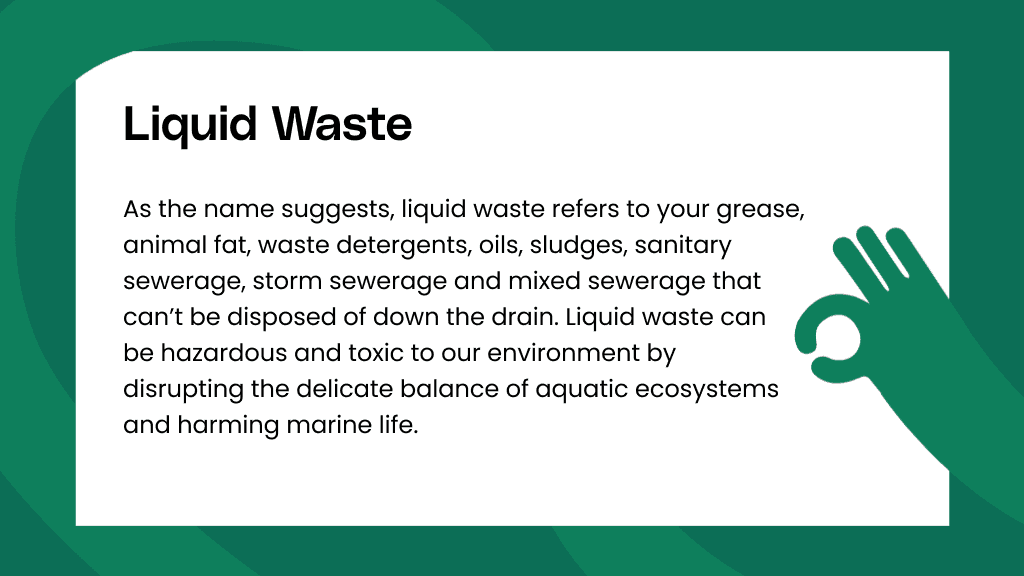The Ultimate Guide To Reclaim Waste
The Ultimate Guide To Reclaim Waste
Blog Article
The Greatest Guide To Reclaim Waste
Table of ContentsNot known Facts About Reclaim WasteThe Basic Principles Of Reclaim Waste Unknown Facts About Reclaim WasteEverything about Reclaim WasteNot known Facts About Reclaim Waste
Domestic sewer waste refers to the waste and products from a residential septic storage tank. The correct administration and disposal of domestic sewage waste call for liquid waste to be moved to a sewage treatment plant where the appropriate techniques and tools are applied to cleanse and dispose of waste.
Commercial waste usually includes prospective hazards, such as flammable products or a mixture of liquid and strong waste items, and calls for an advanced and comprehensive disposal process. The disposal of commercial waste commonly involves the filtering of waste before transport to make certain risk-free and appropriate disposal. Hazardous waste is created from by-products and overflow of commercial processes and production.
This sort of waste can not make use of the exact same sewage administration transportation or processes as septic or business fluids. The commercial waste management process requires the examination and testing of liquid waste before it goes through the disposal process (industrial wastewater treatment). Runoff waste is the liquid waste that comes from runoff and excess stormwater in extremely inhabited locations or cities
Runoff waste can trigger contamination and flooding if not taken care of properly. Making certain proper waste management can protect against calamities and minimize environmental injury.
The Buzz on Reclaim Waste
Contact PROS Services today to discover our waste monitoring and disposal services and the appropriate ways to take care of the liquid waste you generate.
(https://www.anyflip.com/homepage/imqzz#About)This supposed 'wastewater' is not only an important resource yet, after treatment, will certainly be released to our land, rivers or the ocean. Made use of water from commodes, showers, bathrooms, cooking area sinks, washings and commercial processes is recognized as wastewater.

water made use of to cool equipment or tidy plant and equipment). Stormwater, a form of wastewater, is runoff that streams from farming and metropolitan locations such as roof coverings, parks, yards, roadways, paths and gutters into stormwater drains pipes, after rainfall. Stormwater flows untreated directly to local creeks or rivers, at some point getting to the ocean.
How Reclaim Waste can Save You Time, Stress, and Money.
In Queensland, many wastewater is dealt with at sewer therapy plants. Wastewater is transferred from residential or commercial websites with a system of sewers and pump stations, called sewerage reticulation, to a sewage treatment plant. Regional governments develop, preserve and run most sewer treatment plants. Operators are certified under the Environmental Management Act 1994 to release treated wastewater at an acceptable environmental requirement into waterways.
The Department of Natural Resources recommends local federal governments concerning handling, operating and preserving sewerage systems and therapy plants. In unsewered areas, city governments might call for householders to set up specific or house sewer therapy systems to deal with residential wastewater from toilets, cooking areas, bathrooms and laundries. The Division of Natural Resources authorizes using household systems when they are verified to be effective.
In some new communities, treatment of some stormwater to get rid of litter, sand and crushed rock has begun making use of gross contaminant catches. Wastewater treatment occurs in 4 stages: Gets rid of strong issue.
Makes use of tiny living microorganisms recognizes as micro-organisms to break down and get rid of staying liquified wastes and fine bits. Micro-organisms and wastes are incorporated in the sludge.
10 Simple Techniques For Reclaim Waste
Nutrient elimination is not available at all sewer treatment plants because it requires costly specialist devices. Clear liquid effluent produced after therapy might still include disease-causing micro-organisms - liquid waste disposal melbourne.

Many wastewater streams right into the sewerage system. Under the Act, regional governments provide authorizations and permits for eco appropriate tasks (Periods) entailing wastewater releases that might have a neighborhood impact.
The Main Principles Of Reclaim Waste
Surveillance provides factual information regarding water high quality and can verify that licence conditions are being satisfied. The info acquired see this site with tracking supplies the basis for making water high quality choices.
Report this page